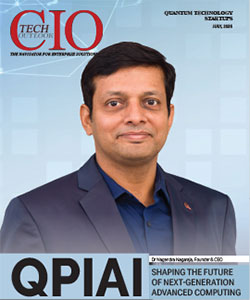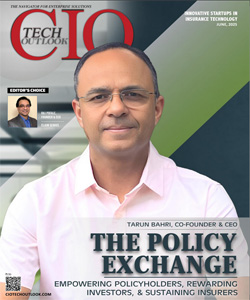The CIO's Path to a Seamless Omni Channel Customer Experience
By Sudhakar Singh, Editor, CIOTechOutlook | Wednesday, 01 November 2023, 11:51 IST

The global customer experience management market is expected to become worth more than USD 52 billion by 2030, growing at a CAGR of over 16 percent. As customers increasingly expect the interactions to be integrated across channels, ensuring a seamless omni-channel experience has become of paramount importance. On this path, the challenge for CIOs is to interweave data, technology, and processes to create a robust fabric of customer journey. They are looking to break down the silos between different systems and leverage data analytics while ensuring data security. Moreover, to be able to offer personalized experiences, they are strategizing to align marketing and sales.
On the path to achieve a seamless omni-channel customer experience, there are some key areas that need special attention of the CIOs.
Data Integration and Centralization
CIOs are pivotal players in their organization, as they guarantee the omni-channel experience which is integrated, through data integration and centralization. Using data from multiple sources, like e-commerce sites, mobile apps, and physical outlets, the CIOs can form a single customer view. With this central data warehouse, it becomes possible to have a 360-degree view of every customer, guaranteeing that uniform and personalized interactions will take place across all channels. The CIOs can embed within the enterprise integrative data systems and approaches that link the disparate data sources, thus providing the sales, marketing, and service teams with data available in real time. Through this approach, businesses can build customer loyalty, strengthen their brands, and boost business growth in the era of information explosion and multi-channel trade.
One of the most amazing examples illustrating data integration and centralization by CIOs for creating omni-channel experience is of Walmart. Walmart that has a vast network of brick and mortar stores and a rising e-commerce presence understands the need to bring together data from different points to provide its customers with a uniform shopping experience. They brought together all data, ranging from in-store purchases to online orders, mobile apps and loyalty programs, into a single database. These enabled Walmart to offer personalized recommendations, maintain uniform pricing and supervise inventory across channels. Thus, its clients started having a comprehensive flow, both in-store and online, resulting in the growth of customer loyalty and sales turnover.
“There are still islands, and we need to bring together the islands, not by brute force, but by an elegant solution that is incarnated in a control plane,” says Dr. Stefan Sigg, Chief Product Officer, Software AG.
Scalable and Flexible Technology Stack
Another crucial aspect of creating a seamless omni-channel experience is to build scalable and flexible technology stacks. CIOs must adopt modern, cloud-based solutions that provide agility and scalability to meet the demands of evolving consumer behaviors. These technology stacks should enable data sharing across channels, empowering CIOs to harness insights for improved customer engagement. By choosing robust and adaptable technologies, CIOs can ensure a future-proof infrastructure that can integrate emerging channels and technologies seamlessly. In this way, they can guarantee that their organizations stay at the forefront of delivering consistent, personalized experiences to customers, enhancing brand loyalty and competitiveness in the omni-channel landscape.
A case in point is of Amazon whose relentless focus on customer experience across various channels led to the creation of Amazon Web Services (AWS). By developing AWS as an independent and scalable cloud computing platform, Amazon not only met its own needs but also transformed the cloud services industry. AWS enabled Amazon to manage its extensive e-commerce operations efficiently while also providing cloud solutions for other businesses. This adaptability allowed Amazon to scale seamlessly during peak demand, ensuring a consistent shopping experience for its customers and demonstrating how a flexible technology stack can drive success in the omni-channel landscape.
“The right tech stack is not just about the technologies you choose but also about how well they align with your vision, your team and your commitment to delivering a great user experience,” says Sanket Firodiya, cofounder and CTO, Hammr.
Cross-Channel Analytics and Personalization
With the help of the data analytics, CIOs can see who is buying on which channels and understand the trends and preferences of customers. This data can be used to generate tailor-made experiences, where clients are provided with the appropriate content and offers. For instance, personalization offers the guarantee that consumers receive uniform communication and experiences, the same way they use various channels. With this kind of technology and tools, CIOs are able to align the customer data from all channels, in a way that allows for the development of an overall view of the customer journey. This can help organizations deliver personalized solutions and deepen customer engagement hence a more multi-channel services experience.
In particular, the case of Netflix comes to the light; it utilizes sophisticated data analytics to give personalized suggestions and a uniform viewing experience on all the channels. By processing user data, for example, the viewing history and preferences of users, it provides content suggestions which are tailored to the needs of individual viewers. The data-driven system guarantees that regardless of which device they are streaming from; be it TVs, tablets, or smartphones, they will get personalized content recommendations suited to their preferences. This customization does not only make the user experience superior, but also increases subscribers' engagement and loyalty showing how cross-channel analytics boosts an omni-channel operation.
“Insights from AI can foster meaningful interactions and experiences. Guided by a human focus, brands can utilize AI to forge deeper consumer connections for the future,” says Raviteja Dodda, cofounder, and CEO of MoEngage.
As technology continues to evolve, so will the expectations of consumers. Omni-channel customer experience will become increasingly sophisticated, offering seamless, personalized interactions across various channels. CIOs will need to adapt by harnessing the power of AI and data analytics to provide hyper-personalization. Moreover, they will face the critical task of ensuring data security and privacy as the volume of customer data grows. The integration of voice-activated devices, IoT, virtual reality, and augmented reality will necessitate the flexibility to embrace new technologies while safeguarding user experiences. CIOs must become the architects of this transformative journey, marrying innovation with security and personalization to meet future customer experience demands.




